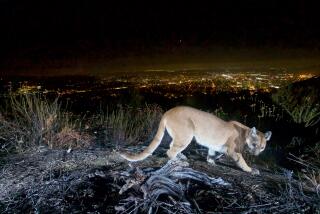Editorial: California needs housing, but not in mountain lion country
The mountain lions of Southern California — facing dangerous freeway traffic, lethal poisons in their prey and the continued encroachment of humans into their habitat — are threatened with extinction. The question now is how much we care and what we’re willing to do, spend or sacrifice to protect them.
The state outlawed hunting mountain lions three decades ago, so we haven’t decimated them the way we did the grizzly bear. There are estimated to still be almost 6,000 in the state.
But wildlife experts say the number of mountain lions in central coastal and Southern California — genetically distinct subpopulations of the species — is so alarmingly low that they are in danger of becoming extinct. So the Center for Biological Diversity and the Mountain Lion Foundation have petitioned the California Fish and Game Commission to list all these groups of mountain lions, also known as cougars, as threatened under the California Endangered Species Act.
The petition lays out a grim scenario of life today for mountain lions: They are fatally hit by vehicles, poisoned by rodenticides or killed in fights with other cougars over territory (and lack of it.) They suffer burns from wildfires. They are genetically weakened from inbreeding. If they make the mistake of preying upon a rancher’s livestock or someone’s pet goats or alpacas, they could end up the target of a “depredation permit” sanctioning their killing.
Wildlife experts say the number of mountain lions in central coastal and Southern California is so alarmingly low that they are in danger of becoming extinct.
In the city of Los Angeles and around it, they live in archipelagos of mountain habitats or — in the case of the famous cougar P-22 — in Griffith Park, hemmed in by roads and freeways and housing developments. The leading threats to their survival are “habitat fragmentation” from urban development, and the lack of specially constructed wildlife crossings enabling them to cross freeways and move safely from one part of their habitat to another, experts say.
But here’s the problem: If the lions were to be listed for protection, it would mean that any housing development or transportation project would be legally required to avoid harming lions’ habitats and to preserve their pathways to open spaces and “connectivity” to the habitats of other mountain lions. And California is in the midst of a desperate housing crisis that is fueling homelessness, harming low-income communities and making it harder to attract and retain businesses; policymakers at the state and local level are strongly encouraging new construction and development.
Earlier this year, for instance, the Los Angeles County Board of Supervisors approved the Centennial mega-development of 19,000 residences in the upper northwest corner of the county, despite warnings from the Santa Monica Mountains Conservancy that the development would sever a five-mile wide wildlife habitat linkage across Highway 128. This page editorialized against the project for its sprawl into a remote area, its inherent fire risks and the fact that it would result in more people driving long distances to work, creating extra traffic and greenhouse gas emissions.
The supervisors also approved a mixed-use development near Castaic, called NorthLake, that would create 3,150 homes despite objections from environmental groups and the California Department of Fish and Wildlife that the development would harm crucial linkages for mountain lions and other wildlife between the Angeles National Forest and the Los Padres National Forest. Supervisor Kathryn Barger, who represents the area, said that it fulfilled a need for housing. The Center for Biological Diversity and the Endangered Habitats League are suing the county in an attempt to stop that development.
Enter the Fray: First takes on the news of the minute »
More such projects are bound to be proposed. If mountain lions were to be listed as threatened, these developments would be required to preserve existing corridors and protect habitats for mountain lions. New roads and freeways would have to include wildlife crossings. Would developers balk? Probably. One expert on property rights and environmental law says listing mountain lions would limit property owners’ ability to develop in wide swaths of land near the Santa Monica and San Gabriel mountains by increasing the cost of projects.
But as severe as the housing crisis is in California, it must be addressed in a manner that comports with the state’s other goals, including limiting emissions, protecting against wildfires, curtailing sprawl, promoting conservation — and preserving wildlife.
The staff of the Department of Fish and Wildlife will spend months studying this issue before making a recommendation to the commission. As they do, they should remember that not only are mountain lions a majestic reminder of a time when wildlife roamed abundantly, but, as “apex predators,” they are also key players in the ecosystem, helping support healthy habitats for aquatic and land animals.
The state must take seriously the precarious status of mountain lions. Preserving their habitat not only helps ensure their survival but also helps ensure the preservation of wild, open space for all of us.
Follow the Opinion section on Twitter @latimesopinion or Facebook
More to Read
A cure for the common opinion
Get thought-provoking perspectives with our weekly newsletter.
You may occasionally receive promotional content from the Los Angeles Times.










